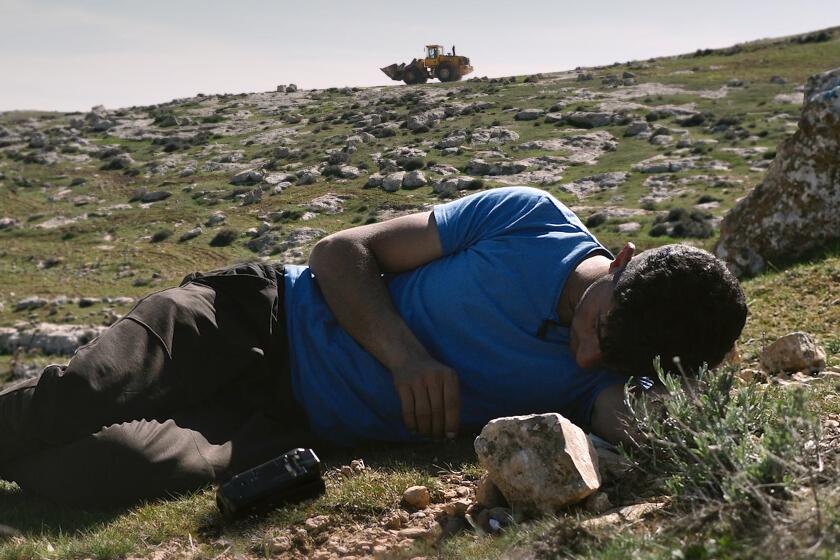Review: Observing Christo’s balancing act in art documentary ‘Walking on Water’
- Share via
The art of Christo and his late wife, Jeanne-Claude, consists of large, outdoor installations comprising fabric walls, oversize umbrellas, and islands, buildings and coastlines draped or surrounded in fabric. Each project requires hundreds of professional and amateur collaborators for their evanescent realization, inviting the gaze of photographers and filmmakers, and welcoming crowds who traverse canyons, lakes and seacoasts dramatically transformed by fluttering textiles. By the 1970s, the French, Moroccan-born Jeanne-Claude and her Bulgarian husband had attained celebrity status, their environmentally conscious democratization of art in perfect alignment with the zeitgeist.
Critics have labeled them conceptual artists, frauds, intellectuals and post-modernists. In Andrey M. Paounov’s “Walking on Water,” Christo is the archetypal artist, stubbornly maintaining the purity of his vision, in this case, allowing people to walk on water. Anchoring thousands of interconnected polyethylene boxes to the depths of Lake Iseo in the Lombardy region of Italy, Christo created “floating piers” between two islands on the lake, surrounding one of them, Isola di San Paolo, in sunflower yellow fabric. Streets in Sulzano and Peschiera Maraglio, where visitors arrived, were also draped, along with the buoyant pathways. The project, whose roots reach back several decades, is credited to both Christo and Jeanne-Claude, who died in 2009.
Among the dozens of documentaries that preceded this one, filmmakers meticulously recounted each stage of the artists’ process, from concept, to the gaining of permissions and licenses, to the selling of drawings that support the work, and finally to construction and the communal experience that is Christo and Jeanne-Claude’s raison d’etre. Early portrayals by Albert and David Maysles, such as “Christo’s Valley Curtain” (1974), and “Running Fence” (1977), relied on interviews with the artists and their collaborators and were celebrated works of art in their own right. Other documentaries relied on montages of the artists’ international projects set to classical music, with bird’s-eye views, for instance, of islands in Florida surrounded in pink fabric.
Paounov’s approach is fly-on-wall, drawn from 700 hours of footage provided by Christo of the project’s gestation as well as some original footage shot by the filmmaker. While Paounov illustrates the stages of the project with admirable brevity and maintains Christo’s point of view, he fails to introduce the artist’s closest collaborators, his nephew Vladimir Yavachev, and filmmaker and photographer Wolfgang Volz. Eliding an explanation of the roles of major and minor players often muddles the narrative; a case in point is the sequence about who bears responsibility for overcrowding on the floating piers.
The filmmaker’s freewheeling approach works to the documentary’s advantage when it takes its cue from Christo and Jeanne-Claude’s kinetic art that demands motion and life in the moment, in contrast to the contemplative spectatorship required of other art forms. Sequences in which the artist is in his element, standing on a newly completed pier, in the midst of a group of workers, cleverly illustrates his oft-repeated claim that his work relies on “real air” and “real sunlight.” Paounov is apparently not attuned to the aural beauty of Christo’s art; instead of the lapping of the lake against the piers or the sound of the wind rippling the fabric, nonstop pulse sounds and music with no apparent relationship to the subject matter dominate the soundtrack.
It is when Paounov reveals Christo’s leonine qualities that “Walking on Water” achieves a rare authenticity. In one extended sequence, the octogenarian argues with Yavachev over the weight of a chain that will anchor the fabric to the floating pier, and in another he rails at a weary crew for improperly unfolding and draping the fabric. Midway through the documentary, bruised from a fall and momentarily assailable, Christo stalks out of the frame. Paounov cuts to black and then to an open window, the shining pathway in the distance. It is opening day. Soon, Italian authorities will refuse to limit the crowd. For the filmmaker, Christo is the consummate artist because he is in a perpetual state of anxiety, battling the forces of nature and of mediocrity.
------------
‘Walking on Water’
Not rated
Running time: 1 hour, 40 minutes
Playing: Starts Friday, Landmark Nuart, West Los Angeles
More to Read
Only good movies
Get the Indie Focus newsletter, Mark Olsen's weekly guide to the world of cinema.
You may occasionally receive promotional content from the Los Angeles Times.










